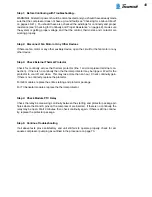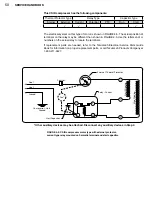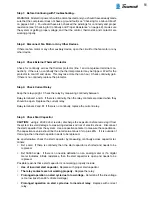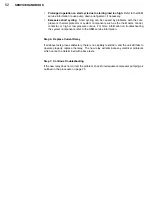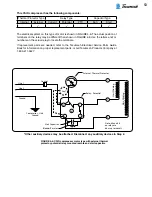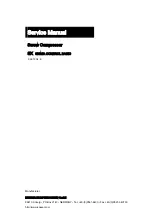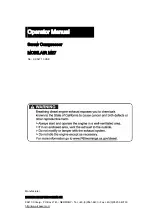
63
Step 1: Before Continuing with Troubleshooting
WARNING! All electric power should be disconnected and you should have already made sure
that the compressor does not have a ground fault (see “Checking for a Ground Fault” on pages
40-41). You should have also checked the windings for continuity and proper resistance (see
“Checking for Continuity and Proper Resistance” on page 42), made sure the system is getting
proper voltage, and that the control, thermostat, and contactor are working properly.
Step 2: Check Wiring
Confirm that there is continuity between C and the protector common lead wire.
Step 3: Check External Thermal Protector
Check for continuity across the thermal protector (line 1 and compressor terminal connection).
If there is no continuity then the thermal protector may be tripped. Wait for the protector to cool
off and close. This may take more than an hour. Check continuity gain. If there is no continuity,
replace the protector.
Step 4: Check Run Capacitor
CAUTION:
using a 20,000 ohm resistor, discharge the capacitor before removing it from the
system to avoid damage to measuring devices and risk of electric shock.
Disconnect the run
capacitor from the system. Use a capacitance meter to check capacitor. Capacitance should
be 10% of the marked capacitor value.
As an alternative, check the run capacitor by measuring continuity across the capacitor termi-
nals:
•
Rx1 scale: If there is continuity, then the run capacitor is shorted and needs to be replaced.
•
Rx100,000 scale: If there is no needle deflection on an analog meter or if a digital meter
indicates infinite resistance, then the run capacitor is open and needs to be replaced.
Possible reasons that a run capacitor is not working properly include:
•
Use of incorrect run capacitor.
Replace with proper run capacitor.
•
Line voltage is too high
(greater than 100% of rated voltage)
.
Step 5: Reconnect Run Capacitor
Reconnect the run capacitor into circuit at terminals S and R. (Marked terminal should go to R.)
Step 6: Add Start Assist Kit
If the compressor checks out satisfactorily on all the above PSC tests but still doesn’t operate,
add proper start assist kit to provide additional starting torque. See Figure 4-11 for proper wir-
ing.
Step 7: Continue Troubleshooting
If all above tests prove satisfactory and unit still fails to operate properly, check for adequate
compressor pumping as outlined in the procedure on page 70.
Summary of Contents for AH5540E
Page 1: ...Hermetic Compressor Service Handbook Wholesale Distribution North America...
Page 2: ......
Page 3: ...Hermetic Compressor Service Handbook Ann Arbor MI 48108 REV 3 11...
Page 4: ......
Page 8: ......
Page 9: ...Chapter 1 General Service Safety Precautions...
Page 16: ......
Page 17: ...Chapter 2 Model and Application...
Page 22: ......
Page 23: ...Chapter 3 Compressor Motor and Component...
Page 36: ......
Page 37: ...Chapter 4 Servicing...
Page 38: ...30 SERVICE HANDBOOK...
Page 79: ...71...
Page 80: ......
Page 81: ...Chapter 5 Installation and Replacement...
Page 96: ......
Page 97: ...Liquid refrigerant migration to compressor FIGURE 6 1 Chapter 6 Operation...
Page 108: ......
Page 109: ...Appendix...
Page 113: ...105 Reciprocating Compressor FIGURE A 2 Internal view of typical air conditioning compressor...
Page 118: ...110 SERVICE HANDBOOK Notes...
Page 119: ......

